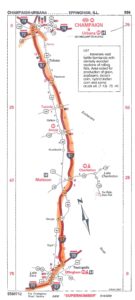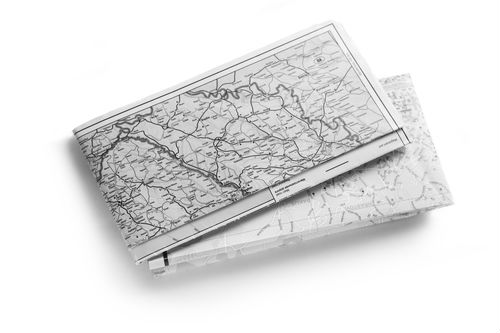It’s summer, and many of us are on the road enjoying vacations. If you undertook a vacation road trip before GPS, you probably used a paper map. When driving in Europe I always bought Michelin maps, which are so large when open that they fill the entire passenger space of a car. Now I use my cellphone Google Maps app, too. I love my $20 Michelins because they offer so many details and opportunities to wander and explore. I also love my phone navigation app that talks to me! Neither is quite the right tool all the time.
When I talk to business owners in both emerging and mature companies, I usually ask them what map guides them—either in their heads or on paper. Sometimes I get, “Do you mean my operating plan for this year?” Others describe their company vision or their plan for post-sale life. Some show me a visual strategy map on their white board; others pull up a 25-page PowerPoint slide deck. Any of these options serves the owners, but none of them fills all of their needs all of the time.
All company owners need a good set of maps
 If only every business came with a packet of roadmaps that were compact, unambiguous and reliable—like that old AAA Auto Club TripTik, where a knowledgeable advisor prepared a customized, highlighted route based on your specific needs and current route conditions. Today, it would be an app with real-time updates and “recalculations” as you navigate a new direction.
If only every business came with a packet of roadmaps that were compact, unambiguous and reliable—like that old AAA Auto Club TripTik, where a knowledgeable advisor prepared a customized, highlighted route based on your specific needs and current route conditions. Today, it would be an app with real-time updates and “recalculations” as you navigate a new direction.
But although business doesn’t come with a map like that, whether you’re an entrepreneur or an owner looking to exit your business, you need a good set of directions that map your particular journey. And while stages in a business are unique, there are some common needs when it comes to navigating.
A good set of business “maps” should meet three criteria:
- They’re the right scale
- They’re current
- They’re handy
As in Exit Signs, I ask questions to help business owners probe their reality, here are a few you might ask yourself about each of these business “map” criteria.
Are your maps the right scale?
Your business operating plan/map shows your course over the year: revenue targets, expense budgets, and capital investment, for example. Or, if you are looking to exit your business, you want a concrete plan to maximize its value and make it salable. You’ll review this plan at least quarterly to see if you are on course or for course corrections. The resolution of this map view is fairly sharp, and the information is very tangible. The scale is comparable to “1 inch = 1 mile.”
On the other hand, you don’t drive from San Francisco to New York City using just street maps. You need a longer horizon. Maybe you use a compass or vision that lets you keep your bearings when forced to detour. Maybe it’s a three-year strategic plan or a vision of life after you sell. You’ll review and adjust it each year. The scale here is like “1 inch = 100 miles.”
Scale lets us know the details of our chosen path forward. So we need it to provide high and low resolution.
Ask yourself:
- Do I have a set of maps that give me the scale and resolution I need to lead my business effectively?
- Do my people know the destination and the route, or is it only in my head?
- How frequently do I synchronize and align these maps?
Are your maps current?
While online navigation can get it wrong when it comes to changing road conditions or closures, it’s pretty certain that using that old 1989 Rand McNally book of maps, you’ll run into some serious unplanned detours, no matter your navigation skills. Yet, when it comes to a business plan, some owners use old but familiar maps.
I worked with an engineering firm having difficulty agreeing on an exit strategy. Each partner cited the firm’s Operating Agreement as the Holy Grail for their individual and conflicting positions. They were navigating their future on a 20-year-old document that had not been reviewed in 10 years.
Ask yourself:
- What do I do to ensure I am using the best current data to build my map? Is the data set complete, i.e., does it look at customers, competitors, technology, talent pools, market shifts?
- How frequently do I update my maps?
- Do my people know the changing nature of our world, or is it only in my head?
Are your maps handy?
It doesn’t take much to know when something is handy and useful vs. cumbersome and inaccessible. For example, in my kitchen, my favorite and “must-have” cooking tools are within three or four steps of me. Most everything else is out of sight and, thus, out of mind.
The same is true of vision statements, strategic plans, and operating budgets. The people they should be guiding—at key decision points—need their maps to be handy or the needed information will also be off the radar screen.
Ask yourself:
- Who still knows the basis of your business or exit plan?
- How accessible are your business maps when key decisions are being made?
- If it doesn’t matter that they aren’t handy, why even have them?
The longer you’re on the road and in business, the clearer you become about what maps are useful. It just depends on what scale, accuracy, and handiness you need. After many years of travel I love my GPS navigation for finding my hotel. I’m comfortable with a simple one-page street map from my hotel when headed for a walk. And in country terrain where cell or Wi-Fi coverage is unpredictable, I want my trusty if unwieldy Michelin, too.
It’s the same with starting a business and eventually selling it—the best-prepared traveler has a set of maps for the beginning, the end, and all the adventures in between.
What maps work for you as an entrepreneur or exiting business owner?

